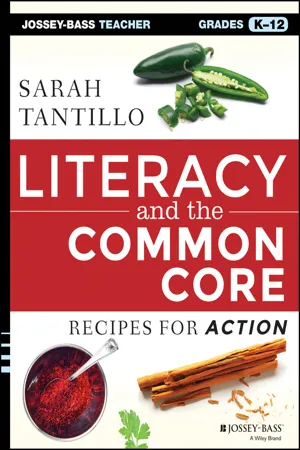
- English
- ePUB (mobile friendly)
- Available on iOS & Android
About This Book
Tools and Insights for Meeting and Exceeding the Common Core Standards
Literacy and the Common Core offers K–12 teachers clear guidance on how to design units, lessons, and objectives to meet the Common Core State Standards in English Language Arts; it's filled with practical strategies that teachers can use immediately to target key standards; and it describes how to analyze the standards to support instructional planning and curriculum development.
This book aims to make life a little easier for everyone—teachers, school leaders, parents, and students—as we all strive to prepare students for college and the careers they most desire. The book includes practical tools, templates, and rubrics ready to be downloaded and customized to meet your needs. Additional resources may be found on the companion site, www.literacycookbook.com.
Here are just a few of the essential topics addressed:
- Which standards to start with and how to tackle them
- How to bridge the gap when students are not on grade level
- How to engage and support parents
- How to teach students to write effectively
- How to translate the standards for actual use
Take the recipes in this book, make them your own, and enjoy your new "Common Core Master Chef" status!
Frequently asked questions
Information

Chapter One
Strategic Planning to Strengthen Curriculum
Strategic Action Planning: How to Make Things Happen
| Topic/Issue/Task | What Do We See? | What Do We Want to See? | What Will We Need to Do in Order to See What We Want to See? | What Resources Will We Need? (including human and fiscal) | When Will We Tackle This Task? |
- Teachers use a common lesson-planning template.
- Teachers are trained in how to write effective RPM (rigorous, purposeful, measurable) objectives and use them in their lesson plans.
- Teachers align objectives with other parts of the lesson plan.
- Teachers receive frequent feedback and support on their lesson plans and instruction.
- Teachers receive coaching on how to unpack the ELA Common Core Standards and design lessons and units based on the Standards.
- Teachers meet regularly for grade-level and vertical articulation in support of curriculum development and other professional development needs.
Table of contents
- Cover
- Title Page
- Copyright
- Online Materials
- Acknowledgments
- About The Author
- Preface: Why I Felt Compelled to Write This Book
- Introduction: What Problems This Book Attempts to Solve, and How
- Part 1: Basic Ingredients
- Part 2: Appetizers
- Part 3: Entrees
- Part 4: Desserts
- Index
- How to Access the Online Materials
- How to Use the Literacy Cookbook Website
- End User License Agreement